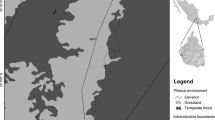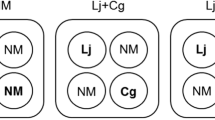Abstract
Plantation forestry with exotic trees in south China needs compatible symbionts to improve the growth of seedlings in nurseries and to enhance establishment and growth in the field. Scleroderma, a potentially suitable symbiont for inoculation, is not being used in containerized nurseries in the region due to poor knowledge of its host range. The ability of 15 collections of Scleroderma, nine from Australia and six from Asia, to colonize and promote growth of four important exotic plantation trees (Eucalyptus globulus Labill., Eucalyptus urophylla ST Blake, Pinus elliottii Engl., and Pinus radiata D. Don) was examined in a nursery potting mix. There was generally low host specificity of Scleroderma between tree genera. At 12 weeks after inoculation, 13 to 14 of the 15 spore collections formed ectomycorrhizas on seedlings of eucalypts or pines. The extent of colonization differed between spore treatments with two or four collections forming abundant mycorrhizas (>50% fine roots colonized) on E. globulus or E. urophylla, respectively, and three or five on P. radiata or P. elliottii, respectively. Three collections from Australia strongly colonized all hosts resulting in 26 to 100% of short roots being colonized. Chinese Scleroderma collections resulted in fewer mycorrhizas on eucalypts than on pines. Inoculation stimulated the growth (shoot height and dry weight) of eucalypt and pine seedlings by up to 105% where Scleroderma mycorrhizas developed. The results suggest that there is a need to source Scleroderma from outside China for inoculating eucalypts in Chinese nurseries whereas Chinese collections of Scleroderma could be used in pine nurseries. Further screening of Australian and Chinese Scleroderma should be performed in Chinese nurseries and in the field before final commercial decisions are made.


Similar content being viewed by others
References
Azevedo N (1982) Ectomycorrhizae del Pinus pinaster Sol. ex Ait. Bol Estac Cent Ecol (ICONA) 11:37–42
Bâ AM, Sanon KB, Duponnois R, Dexheimer J (1999) Growth response of Afzelia africana Sm. seedlings to ectomycorrhizal inoculation in a nutrient-deficient soil. Mycorrhiza 9:91–95
Bakshi BK (1966) Mycorrhiza in eucalypts in India. Indian For 92:19–20
Birch TTC (1973) A synopsis of forest fungi of significance in New Zealand. NZ J For 6:109–125
Brundrett M, Bougher N, Dell B, Grove G, Malajczuk N (1996) Working with mycorrhizas in forestry and agriculture. ACIAR Monograph 32. ACIAR, Canberra, pp 174–182
Brundrett M, Malajczuk N, Gong M, Xu D, Snelling S, Dell B (2005) Nursery inoculation of Eucalyptus seedlings in Western Australia and Southern China using spores and mycelial inoculum of diverse ectomycorrhizal fungi from different climatic regions. For Ecol Manag 209:193–205
Burgess T, Malajczuk N (1990) The effect of ectomycorrhizal fungi on reducing the variation of seedling growth of Eucalyptus globulus. Agric Ecosyst Environ 28:41–46
Cairney JWG, Chambers SM (1999) Ectomycorrhizal fungi: key genera in profile. Springer-Verlag Berlin Heidelberg, New York, pp 369
Chen YL, Brundrett MC, Dell B (200a) Effects of ectomycorrhizas and vesicular–arbuscular mycorrhizas, alone or in competition, on root colonization and growth of Eucalyptus globulus and E. urophylla. New Phytol 146:545–556
Chen YL, Gong MQ, Wang FZ, Zhang MQ, Chen Y (200b) Diversity and colonization of putative mycorrhizal fungi in Eucalyptus plantations in Southern China. For Stud China 2:34–42
Chen YL, Gong MQ, Xu DP, Zhong CL, Wang FZ, Chen Y (200c) Screening and inoculant efficacy of Australian ectomycorrhizal fungi on Eucalyptus urophylla in field. For Res 13:569–576
Chen YL, Gong MQ, Wang FZ, Chen Y (2001) Effects of inoculation with 11 ectomycorrhizal fungal isolates on growth and photosynthesis of Castanopsis hystrix saplings. For Res 14:515–522
Chen YL, Kang LH, Dell B (2004) Some useful macrofungi from Liuxihe National Forest Park, Guangzhou, China. China For Sci Tech 3:35–42
Chen YL, Dell B, Malajczuk N (2006) Effect of Scleroderma spore density and age on mycorrhiza formation and growth of containerized Eucalyptus globulus and E. urophylla seedlings. New For (in press)
Chilvers GA (1973) Host range of some eucalypt mycorrhizal fungi. Aust Plant J Bot 21:103–111
Chu-Chou M (1979) Mycorrhizal fungi of Pinus radiata in New Zealand. Soil Biol Biochem 11:557–562
Colpaert JV, Assche JA van, Luijtens K, Van Assche JA (1992) The growth of the extramatrical mycelium of ectomycorrhizal fungi and the growth response of Pinus sylvestris L. New Phytol 120:127–135
Dell B, Malajczuk N (1995) Fertiliser requirements for ectomycorrhizal eucalypts in forest nurseries and field plantings in Southern China. In: Brundrett M, Dell D, Malajczuk N, Gong M (eds) Mycorrhizas for Plantation Forestry in Asia. ACIAR Monograph 62. ACIAR, Canberra, pp 96–100
Dell B, Malajczuk N (1997) L’inoculation des Eucalyptus introduits en Asie avec des champignons ectomycorhiziens australiens en vue d’augmenter la productivite des plantations. In: Le Tacon F (ed) Champignons et Mycorhizes en Foret. Revue Forestière Française, Numéro spécial 1997, pp 174–184
Dell B, Malajczuk N, Bougher NL, Thomson G (1994) Development and function of Pisolithus and Scleroderma ectomycorrhizas formed in vivo with Allocasuarina, Casuarina and Eucalyptus. Mycorrhiza 5:129–138
Dell B, Malajczuk N, Dunstan WA (2002) Persistence of some Australian Pisolithus species introduced into eucalypt plantations in China. For Ecol Manag 169:271–281
Duñabeitia MK, Hormilla S, Garcia-Plazaola JI, Txarterina K, Arteche U, Becerril JM (2004) Differential responses of three fungal species to environmental factors and their role in the mycorrhization of Pinus radiata D. Don. Mycorrhiza 14:11–18
Dunstan W, Dell B, Malajczuk N (1998) The diversity of ectomycorrhizal fungi associated with introduced Pinus spp. in the Southern Hemisphere, with particular reference to Western Australia. Mycorrhiza 8:71–79
Duponnois R, Founoune H, Masse D, Pontainer R (2005) Inoculation of Acacia holosericea with ectomycorrhizal fungi on a semiarid site in Senegal: growth response and influences on the mycorrhizal soil infectivity after 2 years plantation. For Ecol Manag 207:351–362
Fay DA, Mitchell DT, Parkes MA (1997) A preliminary study of the mycorrhizal associations of tree seedlings growing on mine spoil at Avoca, Co. Wicklow. Special issue. The ecology of old mine sites. Proceedings of a workshop organised by the Mining Heritage Society of Ireland at the Geological Survey of Ireland, 18–19 October 1997
Garbaye J, Delwaulle JC, Diangana D (1988) Growth response of eucalypts in the Congo to ectomycorrhizal inoculation. For Ecol Manag 24:151–157
Garido N (1984) Notes on Scleroderma citrinum Pers. (Mycota-Gasteromycetes) in Pinus radiata forests in Chile. Nova Hedwigia Kryptogamenkd 40:511–516
Ge XZ, Bi GC (1989) Forest mycorrhiza and application. China Forestry, Beijing, pp 1–305
Gomez KA, Gomez AA (1984) Statistical procedures for agricultural research, 2nd edn. Wiley, New York, pp 1–680
Guzmán G, Varela L (1978) Los hongos de Colombia III. Obsercaciones sobre los hongos, liquenes y mixomicetos de Colombia. Caldesia 12:309–338
Hall IR, Brown GD, Byars J (1995) The black truffle—its history, uses and cultivation. New Zealand Crop and Food Research, Christchurch, pp 1–105
Hardy GJ, Burgess T, Dell B (2003) Potential threats of plant pathogens to eucalypts plantations in China. In: Wei R, Xu D (eds) Eucalyptus plantations, research, management and development. Proceedings of the international symposium of eucalypts, Guangzhou, China. World Scientific, Singapore, pp 358–366
Ingleby K, Last FT, Mason PA (1985) Vertical distribution and temperature relations of sheathing mycorrhizas of Betula spp. growing on coal spoil. For Ecol Manag 12:279–285
Jiang JM, Lu BS (2000) High-efficiency intensive culture of industrial timber forest of exotic pines. J Zhejiang For Sci Tech 20:76–79
Lu XH, Malajczuk N, Dell B (1998) Mycorrhiza formation and growth of Eucalyptus globulus seedlings inoculated with spores of various ectomycorrhizal fungi. Mycorrhiza 8:81–86
Malajczuk N, Molina R, Trappe JM (1982) Ectomycorrhiza formation in Eucalyptus I. Pure culture synthesis, host specificity and mycorrhizal compatibility with Pinus radiata. New Phytol 91:467–482
Malajczuk N, Lapeyrie F, Garbaye J (1990) Infectivity of pine and eucalypt isolates of Pisolithus tinctorius on roots of Eucalyptus urophylla in vitro. I. Mycorrhiza formation in model systems. New Phytol 114:627–631
Martin TP, Harris JR, Eaton GK, Miller OK (2003) The efficacy of ectomycorrhizal colonization of pin and scarlet oak in nursery production. J Environ Hortic 21:45–50
Marx DH (1969) The influence of ectotrophic mycorrhizal fungi on the resistance of pine roots to pathogenic infections I. Antagonism of mycorrhizal fungi to root pathogenic fungi and soil bacteria. Phytopathology 59:153–163
Marx DH, Hedin A, Toe IV, SFP (1985) Field performance of Pinus caribaea var. hondurensis seedlings with specific ectomycorrhizae and fertilizer after three years on a savanna site in Liberia. For Ecol Manag 13:1–25
Molina R (1981) Ectomycorrhizal specificity in the genus Alnus. Can J Bot 59:325–334
Omon RM (1996) The effect of some mycorrhizal fungi and media on the growth of Shorea leprosula Miq. cuttings. Bul Penelitian Hutan 603:27–36
Parladé J, Alvarez IF, Pera J (1996) Ability of native ectomycorrhizal fungi from northern Spain to colonize Douglas-fir and other introduced conifers. Mycorrhiza 6:51–55
Pryor LD (1956) Ectotrophic mycorrhizae in renantherous species of Eucalyptus. Nature 177:587–588
Qi SX (2002) Brief introduction of eucalypt cultivation and utilization in China. In: Wei RP, Xu D (eds) Eucalyptus plantations, research, management and development. Proceedings of the international symposium of euclaypts, Guangzhou, China. World Scientific, Singapore, pp 37–41
Rangarajan M, Narayanan R, Kandasamy D, Oblisami G (1990) Studies on the growth of certain ectomycorrhizal fungi in culture media and in the host under axenic conditions. In: Jalali BL, Chand H (ed) Trends in mycorrhizal research. Proceedings of the national conference on mycorrhiza, held at Haryana Agricultural University, Hisar, India, 14–16 Feb, 1990, pp 126–127
Rao CS, Sharma GD, Shukla AK (1996) Ectomycorrhizal efficiency of various mycobionts with Pinus kesiya seedlings in forest and degraded soils. Proc Indian Natl Sci Acad, B Biol Sci 62:427–434
Reddy SM, Satyanarayana T (1998) Inoculation of micropropagated plantlets of Eucalyptus tereticornis with ectomycorrhizal fungi. New For 16:273–279
Reddell P, Milnes AR (1992) Mycorrhizas and other specialized nutrient-acquisition strategies—their occurrence in woodland plants from Kakadu and their role in rehabilitation of waste rock dumps at a local uranium-mine. Aust J Bot 40:223–242
Richter DL, Bruhn JN (1987) Scleroderma spp. ectomycorrhizae for use in greenhouse and nursery to increase Pinus resinosa outplanting success. Mycol Soc Am Newsl 38:45
Richter DL, Bruhn JN (1989) Pinus resinosa ectomycorrhizae: seven host–fungus combinations synthesized in pure culture. Symbiosis 7:211–228
Rincón A, Alvarez IF, Pera J (2001) Inoculation of containerized Pinus pinea L. seedlings with seven ectomycorrhizal fungi. Mycorrhiza 11:265–271
Sanon KB, Bâ AM, Dexheimer J (1997) Mycorrhizal status of some fungi fruiting bebeath indigenous trees in Burkina Faso. For Ecol Manag 98:61–69
Santoso E (1991) Effect of mycorrhizal fungi on nutrient uptake of five dipterocarp seedlings. Bul Penelitian Hutan 532:11–18
Schramm JM (1966) Plant colonization studies on black wastes from anthracite mining in Pennsylvania. Trans Am Philos Soc 56:1–194
Seva JP, Vilagrosa A, Valdecantos A, Cortina J, Vallejo VR, Bellot J (1996) Mycorrhization and application of urban compost for the improvement of survival and growth of Quercus ilex subsp. ballota seedlings in an arid zone. Cah Options Mediterr 20:105–121
Takacs EA (1961) Algunas especies de hongos formadores de mycorrhizas en árboles forestales en la Argentina. Rev For Argent 5:80–82
Thomson BD, Hardy GES, Malajczuk N, Grove TS (1996) The survival and development of inoculant ectomycorrhizal fungi on roots of outplanted Eucalyptus globulus Labill. Plant Soil 178:247–253
Trappe JM (1962) Fungus associates of ectotrophic mycorrhizae. Bot Rev 28:538–606
Xu DP, Bai JY, Dell B (2000) Overcoming the constraints to productivity of plantation eucalypts in Southern China. In: Gong MQ, Xu DP, Zhong CL, Chen YL, Dell B, Brundrett M (eds) Proceedings of ACIAR Workshop on Mycorrhiza, Guangzhou, China
Acknowledgement
The first author is a recipient of PhD scholarships supported by the Australian Department of Education and Training and Murdoch University. The International Foundation for Science provided funds for parts of the research component in China.
Author information
Authors and Affiliations
Corresponding author
Rights and permissions
About this article
Cite this article
Chen, Y.L., Kang, L.H., Malajczuk, N. et al. Selecting ectomycorrhizal fungi for inoculating plantations in south China: effect of Scleroderma on colonization and growth of exotic Eucalyptus globulus, E. urophylla, Pinus elliottii, and P. radiata . Mycorrhiza 16, 251–259 (2006). https://doi.org/10.1007/s00572-006-0039-8
Received:
Accepted:
Published:
Issue Date:
DOI: https://doi.org/10.1007/s00572-006-0039-8




